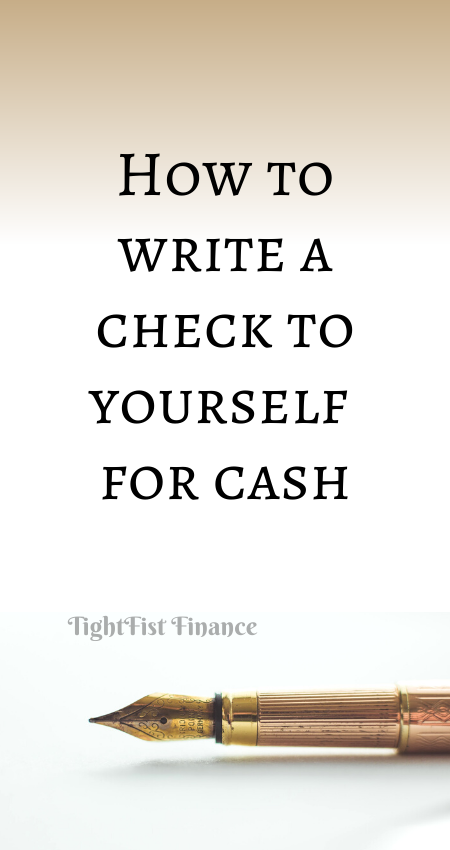How do you write a check to yourself to cash?
Write a check to yourself as you would any check, but put your name in the ‘Pay to the order of’ line. Take your check and identification to any check cashing location to cash the check. Each check cashing location may place fees or limitations on check cashing.
Imagine, being able to get quick cash on the go. You have a checkbook and there is no ATM in sight.
Writing a check to yourself is a quick way to get cash when you need it.
Luckily for you, I’ll show you how to write a check to yourself and cash it. I’ll show you how to minimize check cashing fees and the best locations to cash a check. You’ll have your money in no time!

This article may contain affiliate links which pay a commission and supports this blog. Thank you for your support!
Can you write your own check and cash it?
You can write a check to yourself and cash it. However, you will need to ensure you have enough money in your checking account to cover the check amount. Certain check cashing stores or locations may charge fees or place limits on check cashing, so bank withdrawals are preferred.
Your biggest concern when cashing your own check should be check cashing fees. Each check cashing location will charge a fee for cashing checks.
For example, you might go to Walmart for check cashing services and be charged a fee between $4 and $8. However, check cashing stores (e.g. Money Tree) may charge by a percentage, typically 2-5% of the check amount.
Therefore, a $200 check might cost you $4 at Walmart. The same check could cost you between $4 and $10 at a check cashing store.
You should also be aware that each check cashing location places limits on how much you can cash. For example, Walmart will only cash two-party checks up to $200. However, Money Tree doesn’t place limits on how much money you can cash.
Can I write a check to myself with no money in my account?
Cashing a check with insufficient funds may result in overdraft fees and penalties. Some banks have overdraft protection and others may allow short-term overdrafts depending on your account agreement. Technically, overdrafting your account is a form of taking on debt, meaning you can face legal consequences for not paying it back.
Typically, banks will let your account be overdrawn for 45-60 days while your account accrues interest. Failure to repay may result in account closure, seizure of funds, and sometimes legal consequences.
However, you need to check with your bank and see what their overdraft policy contains. Some banks will have stricter policies in place for overdrafts.
For example, your bank may have overdraft protection turned on, reducing the chances of overdrafts. Other bank accounts may only let your account be overdrawn for 15 days. Your situation depends on what the agreement states when you opened the account.
How to write a check to yourself for cash?
Write a check to yourself by writing your name on the ‘Pay to the order of’ line. Fill out the amount, date, and sign the check. Take the check to your desired check cashing location, such as a store service center or check cashing store. The clerk will take your check and review your ID before giving you the cash equivalent.
Where can I write a check to myself and cash it?
You can write a check to yourself and cash it at select banks, credit unions, grocery and retail store customer service centers, cash advance stores, and gas station Travel Centers. Each location offers a convenient source for check cashing, but fees vary depending on location.
Summary: How to write a check to yourself for cash
As you can see, to write a check to yourself and cash it is fairly simple. Write a check like normal, but make the check out to yourself. Take the check to your preferred check cashing location with your identification. Keep in mind, each check cashing location may place limits and fees on check cashing.
Withdrawing money from your bank is preferred. You won’t incur any fees from performing a bank withdrawal. ATM withdrawals are a close second. You can withdraw up to your ATM withdrawal limit and incur minimal fees.
Alternatively, you can go to banks, credit unions, customer service centers, cash advance stores, and gas station travel centers.
Do not try to cash a check if you do not have enough money in your checking account to cover it. You could be charged an overdraft fee and you’ll be responsible for paying the amount back.
Recommended
Based on this article, we think you’ll enjoy the following:
- How to deposit or cash a personal check at an ATM
- Where can I order checks?
- How to cancel a check and stop payment
- Can I deposit a check for someone else?
- How to make and print your own checks
- How to cash a check without id
- What is a single vs duplicate check? Which is better?
- How to get a cancelled check
- Check cashing places open on a Sunday
- How do check cashing places work?
- Can you cash someone else’s check?
- How old do you have to be to cash a check
- Best places to cash a check for free
